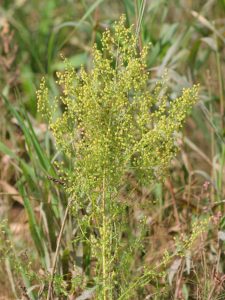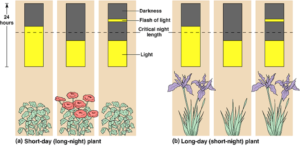The 25th of April is World Malaria Day so this month we’re going to look at a plant that has become famous for helping to combat this devastating disease. It’s possible that you had not heard of Artemisia annua (sweet wormwood) until 2015 when Tu Youyou, who first discovered the compounds artemisinin and dihydroartemisinin, was awarded the Nobel Prize in Physiology or Medicine for her work on these antimalarial drugs.

So how does this plant help with malaria?
As you may have guessed from the name artemisinin can be extracted from Artemisia annua. This is relatively easy using a low boiling point solvent such as diethyl ether. New plant growth has been found to have the highest concentrations of the compound, found in the trichomes of the leaves, stem and inflorescences. Dihydroartemisinin is the active metabolite of artemisinin. Originally these drugs were produced via plant extracts but demand greatly outstripped supply so it is currently manufactured using genetically engineered yeast. Between 2005-08 the market price has fluctuated from 120USD to 1200USD per kg.

The mechanism of action of artemisinin and its derivatives is not fully understood but the endoperoxide bridges in the molecule are thought to be cleaved by iron, releasing free radicals (epoxides and hypervalent iron-oxo species) that go on to damage biological macromolecules. Malaria causing parasites are largely found in red blood cells, which contain iron-rich heme groups and the parasites feed on these, producing hemozoin. Any drug that has such a broad action is going to have potentially serious side effects and taking artemisinin is not going to make you feel much better whilst it’s doing it’s job. The free radicals it produces will also damage your blood cells so you will continue to have a fever and feel weak whilst the parasite is being dealt with. The drug itself has a short half life of 2-5 h.
Ohoo, that’s cool, will I have any success growing it at home?

Sweet wormwood is a short day plant. This means it will only produce flowers when the day length is less than 12 h. You may have a few houseplants like this- poinsettias and christmas cacti are good examples. Plants detect day length using photoreceptor proteins phytochrome and cryptochrome. Phytochrome has two forms and red light (present during the day) converts it to the active form- Pfr. This then triggers the plant to grow. When the plant is in deep shade or it is night time, the Pfr slowly converts back to Pr, the inactive form that does not allow for plant growth. Long day plants are more tolerant to dark periods being interrupted by red light but in short day plants this can prevent them from flowering. Cryptochromes appear to control developmental gene expression in plants in a light dependent manner as well as regulating the circadian clock. They respond to blue light and UVA (hence the whole “get off your phone to sleep better”) and are thought to have evolved from DNA photolyases. Both photoreceptors work together to control the plant’s response to light.

One of the take home messages from the artemisinin story has to be that ethnobotany should never be dismissed as unimportant. Sweet wormwood was used for over 2,000 yrs by Chinese herbalists to treat malaria- the first records of such date back to 200 BCE. Nature can offer us the key to solving many problems if we look carefully!
